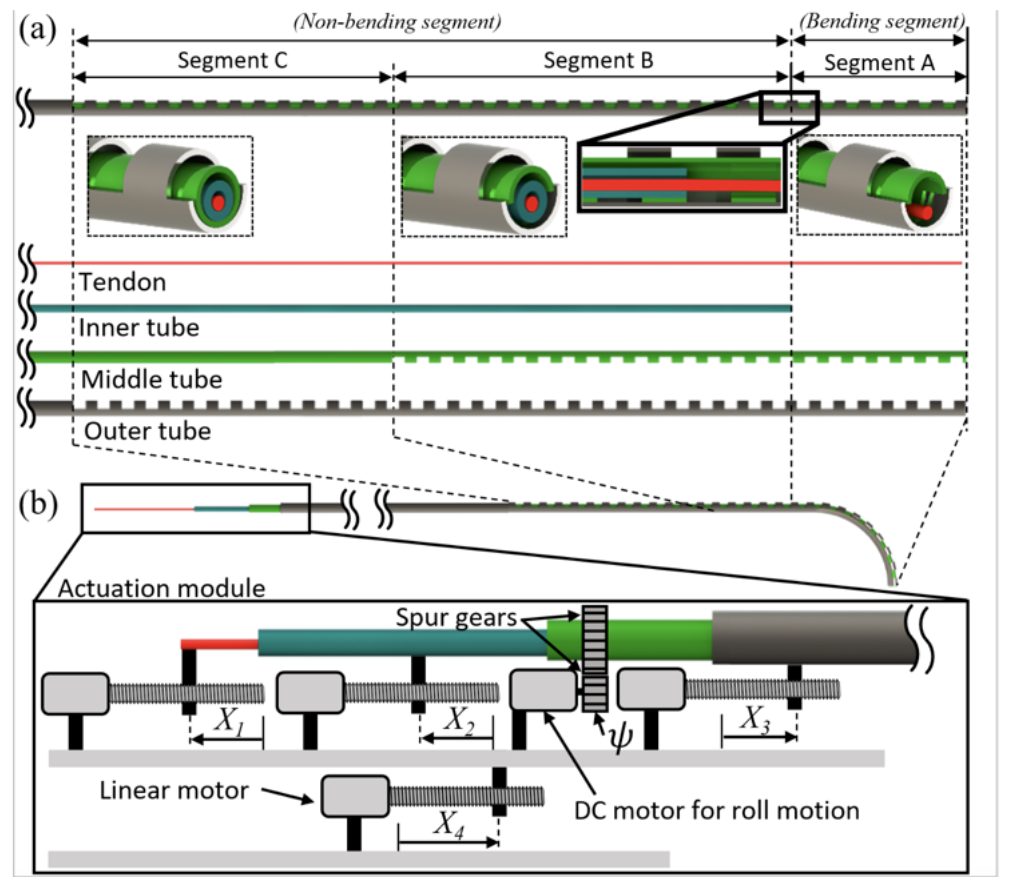This robotically steerable guidewire is designed to replace and improve conventional vascular intervention treatments that use a passive guidewire. Such treatments require manual guidewire navigation, which can lengthen procedure times and radiation exposure, in addition to being prone to wire kinking and breakage.
Georgia Tech’s innovation instead employs robotic rather than manual navigation with a tendon-driven coaxially aligned steerable (COAST) guidewire robot mechanism that can simultaneously and independently control the bending angle and the length of a particular bending section of the wire. The robot also executes “follow-the-leader” motion in the bending section, and its concept can be extended to multiple bending sections and degrees of freedom of the guidewire. This miniaturized (0.4 mm outer diameter) robotic system is designed for a wide variety of endovascular interventions; under suitable conditions, the guidewire would be capable of advancing through complex vasculature of varying curvatures with minimal interaction and support from the vessel walls.
Georgia Tech has filed for patent coverage for this technology as “Systems and Methods for the Control of Multiple Degrees-of-Freedom Bending and the Bending Length of a Coaxially Aligned Robotically Steerable Guidewire."
- Robotic: Provides operational improvement of guidewire navigation to facilitate catheter placement by employing robotics, while most other commercially available guidewires lack active steering capability
- Versatile: Controls the guidewire bending angle and also adjusts the bending length of the joint, increasing the capabilities of the guidewire and accommodating varied vasculature geometries
- Flexible: Can be extended to multiple bending sections and degrees of freedom, in stark contrast to passive guidewires that offer clinicians very limited degrees of freedom
- Treatment-enhancing: May potentially reduce total intervention procedure time—which may also decrease radiation exposure and improve patient outcomes—and lessen the operator’s effort
- Miniaturized: Features an outer diameter of just 0.4 mm, making for a compact design that increases its procedural flexibility and applicability as well as its compatibility with commercially available guidewires
- Medical and surgical applications
- Endovascular interventions (i.e., cardiovascular, neurovascular, and other vascular procedures)
- Steerable robotic devices for minimally invasive and other surgeries
- Steerable needles, endoscopes, and other medical devices
- Civil engineering and search-and-rescue operations
- Navigation of micro-scale cameras and scopes
Minimally invasive treatment of most cardiovascular diseases involve insertion of a guidewire from a suitable location in the patient’s vasculature to the blocked or diseased blood vessel, enabling placement of a variety of catheters to help remove the blockage. In most cases, this guidewire is passive, and its navigation is largely manual, with proximal insertion, retraction, and rotation being the only degrees of freedom available to the clinician to control the distal tip. This manual control can be made difficult by angulation, vessel tortuosity, or calcification of the blood vessel. It can also result in kinking and breakage of the guidewire. While the option to chain the wire to a second, stiffer guidewire may help address these issues, it comes at the cost of additional complexity and risk of twisting the wires. All of these challenges in manual guidewire navigation add up to increased procedure times and the potential for lengthened radiation exposure for patients.
Georgia Tech’s innovation is designed to elegantly address these shortcomings through a miniaturized, robotic system with multiple degrees of freedom that automatically steers the guidewire and thereby decreases clinician effort and potentially shortens intervention times. This broadly applicable solution has the potential to improve a wide array of procedures used to treat cardiovascular diseases that are among the top ten leading causes of death in the United States.

The basic structure of Georgia Tech’s robotically steerable guidewire.
